Cooperativity - Study guides, Class notes & Summaries
Looking for the best study guides, study notes and summaries about Cooperativity? On this page you'll find 177 study documents about Cooperativity.
All 177 results
Sort by
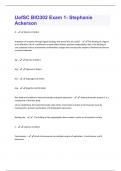 Popular
Popular
-
UofSC BIO302 Exam 1- Stephanie Ackerson Questions And Answers Graded A+
- Exam (elaborations) • 14 pages • 2024
-
 ACADEMICMATERIALS
ACADEMICMATERIALS
-
- $7.99
- 2x sold
- + learn more
A - Alanine (1 letter) Activation of enzymes through ligand binding: why would this be useful? - The binding of a ligand to an allosteric site of a multimeric enzyme often induces positive cooperativity, that is the binding of one substrate induces a favorable conformation change and increases the enzyme's likelihood to bind to a second substrate. Ala - Alanine (3 letter) Arg - Arginine (3 letter) Asn - Asparagine (3 letter) Asp - Aspartic Acid (3 letter) Barr body and relation to heter...
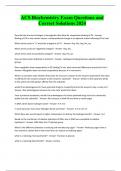 Popular
Popular
-
ACS Biochemistry Exam Questions and Correct Solutions 2024
- Exam (elaborations) • 3 pages • 2024 Popular
- Available in package deal
-
 AdelineJean
AdelineJean
-
- $9.99
- 1x sold
- + learn more
ACS Biochemistry Exam Questions and Correct Solutions 2024 Describe the structural changes in hemoglobin that allow for cooperative binding of O2 - Answer - Binding of O2 in one subunit causes a conformational change in an adjacent subunit allowing O2 to bind Which amino acids in "a" would be charged at pH 7? - Answer -Asp, Glu, Arg, His, Lys Which amino acids are negatively charged? - Answer -Asp, Glu which amino acids are positively charged? - Answer -Arg, His, Lys How are beta sheets s...
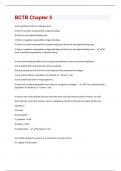
-
BCTB Chapter 5 Questions And Answers With Latest Quiz
- Exam (elaborations) • 21 pages • 2024
- Available in package deal
-
 ACADEMICMATERIALS
ACADEMICMATERIALS
-
- $7.99
- + learn more
A Hill coefficient (nH) of 2 indicates that: A) there is positive cooperativity in ligand binding. B) there are two ligand-binding sites. C) there is negative cooperativity in ligand binding. D) there is positive cooperativity in ligand binding and there are two ligand-binding sites. E) there is negative cooperativity in ligand binding and there are two ligand-binding sites. - A) there is positive cooperativity in ligand binding. A monoclonal antibody differs from a polyclonal antibody in...
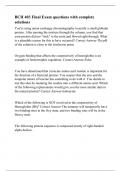
-
BCH 403 Final Exam questions with complete solutions
- Exam (elaborations) • 50 pages • 2024
-
cracker
-
- $14.49
- + learn more
You're using anion exchange chromatography to purify a small globular protein. After passing the mixture through the column, you find that your protein did not "stick" to the resin and flowed right through. What is a plausible reason for this to have occurred? Correct Answer-The pH of the solution is close to the isoelectric point. Oxygen binding that affects the cooperatively of hemoglobin is an example of heterotrophic regulation. Correct Answer-False You have determined that a leucin...
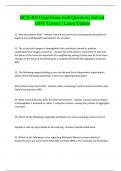
-
BCH 403 Final Exam with Questions Solved 100% Correct | Latest Update
- Exam (elaborations) • 23 pages • 2024
-
 Examsplug
Examsplug
-
- $12.99
- + learn more
E1: Why do proteins fold? - Answer A and B are correct (It is entropically favorable for water & It is enthalpically favorable for the protein) E1: The structural changes in hemoglobin that contribute toward its positive cooperativity for oxygen consist of: - Answer All of the above ( movement of iron into the plane of the heme & movement of a neighboring veiling residue due to strain from changes in the heme & the breaking of a covalent bond with the regulatory molecule BPG
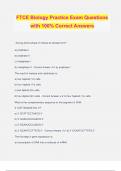
-
FTCE Biology Practice Exam Questions with 100% Correct Answers
- Exam (elaborations) • 32 pages • 2024
- Available in package deal
-
 KatelynWhitman
KatelynWhitman
-
- $13.49
- + learn more
FTCE Biology Practice Exam Questions with 100% Correct Answers During which phase of mitosis do tetrads form? a) prophase I b) prophase II c) metaphase I d) metaphase II - Correct Answer ️️ -a) prophase I The result of meiosis and cytokinesis is: a) two haploid (1n) cells b) four haploid (1n) cells c) two diploid (2n) cells d) four diploid (2n) cells - Correct Answer ️️ -b) four haploid (1n) cells What is the complementary sequence to this segment of DNA: 5' CGTTAGGAATAC 3...
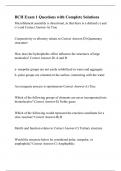
-
BCH Exam 1 Questions with Complete Solutions
- Exam (elaborations) • 9 pages • 2024
-
cracker
-
- $14.49
- + learn more
Microfilament assembly is directional, in that there is a defined (-) and (+) end Correct Answer-A) True Cooperativity or allostery relates to Correct Answer-D) Quaternary strucuture How does the hydrophobic effect influence the structures of large molecules? Correct Answer-D) A and B a- nonpolar groups are not easily solubilized in water and aggregate b- polar groups are oriented on the surface, interacting with the water An exergonic process is spontaneous Correct Answer-A) True ...
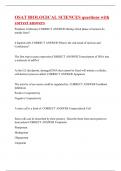
-
OSAT BIOLOGICAL SCIENCES questions with correct answers
- Exam (elaborations) • 19 pages • 2023
- Available in package deal
-
cracker
-
- $13.99
- + learn more
Prophase I (Meiosis) CORRECT ANSWER During which phase of meiosis do tetrads form? 4 haploid cells CORRECT ANSWER What is the end result of meiosis and Cytokinesis? The first step in gene expression CORRECT ANSWER Transcription of DNA into a molecule of mRNA At the G2 checkpoint, damaged DNA that cannot be fixed will initiate a cellular, self-destruct process called: CORRECT ANSWER Apoptosis The activity of an ezyme could be regulated by: CORRECT ANSWER Feedback Inhibition Positive ...
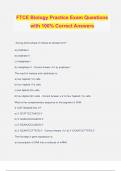
-
FTCE Biology Practice Exam Questions with 100% Correct Answers
- Exam (elaborations) • 32 pages • 2024
- Available in package deal
-
 BrittieDonald
BrittieDonald
-
- $13.49
- + learn more
FTCE Biology Practice Exam Questions with 100% Correct Answers During which phase of mitosis do tetrads form? a) prophase I b) prophase II c) metaphase I d) metaphase II - Correct Answer ️️ -a) prophase I The result of meiosis and cytokinesis is: a) two haploid (1n) cells b) four haploid (1n) cells c) two diploid (2n) cells d) four diploid (2n) cells - Correct Answer ️️ -b) four haploid (1n) cells What is the complementary sequence to this segment of DNA: 5' CGTTAGGAATAC 3...

-
AP Biology AP Exam Review Questions and Answers(RATED A)
- Exam (elaborations) • 10 pages • 2024
-
 IMORA
IMORA
-
- $10.39
- + learn more
Ways of regulating enzymes - ANSWER-allosteric effector competitive inhibition noncompetitive inhibition cooperativity Competitive inhibition - ANSWER-substance the enzyme by occupying the active site Noncompetitive inhibition - ANSWER-substance inhibits the enzyme by binding to a location other than the active site and changes the shape of the enzyme Cooperativity - ANSWER-enzyme becomes more receptive to additional substrates Ribosomes are manufactures in the... - ANSWER-nucleus...

That summary you just bought made someone very happy. Also get paid weekly? Sell your study resources on Stuvia! Discover all about earning on Stuvia


